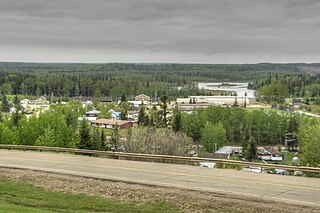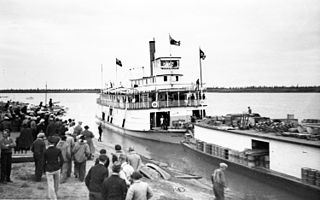Lamson & Hubbard Trading Company (also referred to as Lamson & Hubbard Canadian Co. or Lamson Trading Co.) was an enterprise engaged in the fur trading business in the Canadian North during the early 20th century, with over fourteen outposts in the Athabasca-Mackenzie River district in Alberta and the Northwest Territories. The company was in direct competition with the Hudson's Bay Company and they controlled an estimated 10% of the fur trading market in the north by 1922.
Lamson & Hubbard was also engaged in river transportation. This was primarily to service the company's isolated fur trading posts along the Mackenzie River though the company also offered commercial service through its wholly owned subsidiary, Alberta & Arctic Transportation Company incorporated in 1921. Its flagship on the Alberta to Arctic river route was the S.S. Distributor steam-driven paddlewheeler launched in 1920 at Fort Smith, Northwest Territories to service Lamson & Hubbard's posts along the Mackenzie River, all the way to the delta where it meets the Arctic Ocean.
The company made good profits until about 1921 when fur prices plummeted. Lamson & Hubbard had put all of its capital into expansion, keeping a small a liquid reserve leaving it vulnerable to market volatility. On the other hand, the larger Hudson's Bay Company weathered the storm of falling prices. As a result, the HBC was in a position to systematically attack its rivals' territory and business partners, which Lamson & Hubbard lacked the financial resources or manpower to battle back. [1] This led to the HBC buying out all of the stock in Lamson & Hubbard in 1924, including its transportation wing Alberta & Arctic Transportation, giving the HBC a good measure of dominance in the fur trading and transportation industry of northern Alberta and the Northwest Territories. [2]

The Hudson's Bay Company is a Canadian retail business group. A fur trading business for much of its existence, HBC now owns and operates retail stores in Canada. The company's namesake business division is Hudson's Bay, commonly referred to as The Bay.

Northern Canada, colloquially the North or the Territories, is the vast northernmost region of Canada variously defined by geography and politics. Politically, the term refers to the three territories of Canada: Yukon, Northwest Territories and Nunavut. This area covers about 48 per cent of Canada's total land area, but has less than 1 per cent of Canada's population.

Rupert's Land, or Prince Rupert's Land, was a territory in British North America which comprised the Hudson Bay drainage basin; this was further extended from Rupert's Land to the Pacific coast in December 1821. It was established to be a commercial monopoly by the Hudson's Bay Company (HBC), based at York Factory. The territory operated for 200 years from 1670 to 1870. Its namesake was Prince Rupert of the Rhine, who was a nephew of Charles I and the first governor of HBC.

The North-Western Territory was a region of British North America extant until 1870 and named for where it lay in relation to Rupert's Land.
Peter Pond was an American explorer, cartographer, merchant and soldier who was a founding member of the North West Company and the Beaver Club. Though he was born and died in Milford, Connecticut, most of his life was spent in northwestern North America.

York Factory was a settlement and Hudson's Bay Company (HBC) factory located on the southwestern shore of Hudson Bay in northeastern Manitoba, Canada, at the mouth of the Hayes River, approximately 200 kilometres (120 mi) south-southeast of Churchill. York Factory was one of the first fur-trading posts established by the HBC, built in 1684 and used in that business for more than 270 years. The settlement was headquarters of the HBC's Northern Department from 1821 to 1873. The complex was designated a National Historic Site of Canada in 1936.
Fort Edmonton was the name of a series of trading posts of the Hudson's Bay Company (HBC) from 1795 to 1914, all of which were located on the north banks of the North Saskatchewan River in what is now central Alberta, Canada. It was one of the last points on the Carlton Trail, the main overland route for Metis freighters between the Red River Colony and the points west and was an important stop on the York Factory Express route between London, via Hudson Bay, and Fort Vancouver in the Columbia District. It also was a connection to the Great Northland, as it was situated relatively close to the Athabasca River whose waters flow into the Mackenzie River and the Arctic Ocean. Located on the farthest north of the major rivers flowing to the Hudson Bay and the HBC's shipping posts there, Edmonton was for a time the southernmost of the HBC's forts.

Fort Smith is a town in the South Slave Region of the Northwest Territories (NWT), Canada. It is located in the southeastern portion of the Northwest Territories, on the Slave River and adjacent to the Alberta border along the 60th parallel north.
John Bell was born Isle of Mull, Scotland and emigrated to Canada where he worked for the Hudson's Bay Company as a fur trader and colonizer. He was one of the colonizers of the Yukon River. Bell was appreciated by the company for his "professionalism, flexibility and dedication to the interests of the fur trade" as well as his abilities as a "manager of men".

Fort Assiniboine is a hamlet in northwest Alberta, Canada, within Woodlands County. It is located along the north shore of the Athabasca River at the junction of Highway 33 and Highway 661. It is approximately 39 kilometres (24 mi) northwest of Barrhead, 62 kilometres (39 mi) southeast of Swan Hills and 91 kilometres (57 mi) northeast of Whitecourt.
Samuel Black was a Scottish fur trader and explorer, a clerk in the New North Nest Company (XYC) and Wintering Partner in the North West Company (NWC), and later clerk, chief trader, and chief factor in the Hudson's Bay Company (HBC) for the Columbia District. In 1824, he explored the Finlay River and its tributaries in present-day north-central British Columbia, Canada, including the Muskwa, Omineca and Stikine for the HBC. His journals were published by the Hudson's Bay Record Society in 1955.

The North West Company is a multinational Canadian grocery and retail company which operates stores in Canada's western provinces and northern territories, as well as the US states of Alaska, Hawaii, and several other countries and US territories in Oceania and the Caribbean.

The history of the Northwest Territories covers the period from thousands of years ago to the present day. Prior to European colonization, the lands that encompass present-day Northwest Territories were inhabited for millennia by several First Nations. European explorers and fur traders began to explore the region since the late-16th century. By the 17th century, the British laid claim to both the North-Western Territory and Rupert's Land; and granted the Hudson's Bay Company a commercial fur trade monopoly over the latter region.

The Northwest Territories is a territory in Northern Canada, specifically in Northwestern Canada between Yukon Territory and Nunavut including part of Victoria Island, Melville Island, and other islands on the western Arctic Archipelago. Originally a much wider territory enclosing most of central and northern Canada, the Northwest Territories was created in 1870 from the Hudson's Bay Company's holdings that were sold to Canada from 1869-1870. In addition, Alberta and Saskatchewan were formed from the territory in 1905. In 1999, it was divided again: the eastern portion became the new territory of Nunavut. Yellowknife stands as its largest city and capital. It has a population of 42,800 and has an area of 532,643 sq mi (1,379,540 km2). The current territory lies west of Nunavut, north of latitude 60° north, and east of Yukon.

The Mackenzie River in Canada's Northwest Territories is a historic waterway, used for centuries by Indigenous peoples, specifically the Dene, as a travel and hunting corridor. Also known as the Deh Cho, it is part of a larger watershed that includes the Slave, Athabasca, and Peace rivers extending from northern Alberta. In the 1780s, Peter Pond, a trader with the North West Company became the first known European to visit this watershed and begin viable trade with the Athapascan-speaking Dene of these rivers. The Mackenzie River itself, the great waterway extending to the Arctic Ocean, was first put on European maps by Alexander Mackenzie in 1789, the Scottish trader who explored the river. The watershed thus became a vital part of the North American fur trade, and before the advent of the airplane or road networks, the river was the only communication link between northern trading posts and the south. Water travel increased in the late 19th century as traders, dominated primarily by the Hudson's Bay Company (HBC), looked to increase water services in the Mackenzie River District.

Marine Transportation Services (MTS) formerly Northern Transportation Company Limited (NTCL) is a marine transportation company operating primarily in the Mackenzie River watershed of the Northwest Territories and northern Alberta, and the Arctic Ocean using a fleet of diesel tug boats and shallow-draft barges. NTCL filed for bankruptcy in 2016 and its assets were acquired by the Government of the Northwest Territories later that year.

Revillon Frères was a French fur and luxury goods company, founded in Paris in 1723. Then called la Maison Givelet, it was purchased by Louis-Victor Revillon in 1839 and soon, as Revillon Frères, became the largest fur company in France. Branches were opened in London in 1869 and in New York in 1878. At the end of the 19th century, Revillon had stores in Paris, London, New York City, and Montreal.
The Northern Traders Company was an enterprise engaged in the fur trading business in the north of Canada, with outposts in the Athabasca-Mackenzie River district in Alberta and the Northwest Territories during the early 20th century. They were in direct competition with the Hudson's Bay Company and controlled an estimated 8% of the fur trading market in the north by 1922. Its principal was Colonel J.K. "Peace River Jim" Cornwall who got a start in the Peace River and Lesser Slave Lake district in the early 1900s and expanded north after the 1911 takeover of Hislop & Nagle and their fur trading posts in the Northwest Territories. Northern Traders were engaged in river transportation, primarily to service its own fur trading posts, but they also provided commercial passenger and freight service on their steam-driven vessels. The company went into receivership in 1926 and struggled to remain in business for the next seven years while under the management of creditors. In 1931, the company was liquidated, with all stock being sold to the Hudson's Bay Company, and its transportation arm being sold and reorganized as Northern Waterways Limited.

Aklavik was a small cargo vessel the Hudson's Bay Company used to carry supplies to, and furs from, its outposts in the high Arctic. She was active in the first half of the 20th century.

Distributor was a steamship built for service on the Mackenzie River System. The fast moving waters of the Mackenzie River, and the lower reaches of many of its tributaries, were navigable. Cargo was transported to the north on the Slave River, and had to be portaged overland over a long portage between Fort Smith and Fort Fitzgerald. Some steamship were assembled on tributaries of the Slave River, hauled by tractors over the portage, for service on the lower rivers. Distributor was larger than those vessels, and was built in the north.